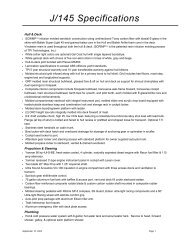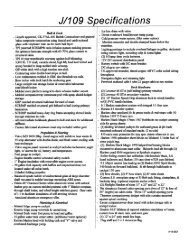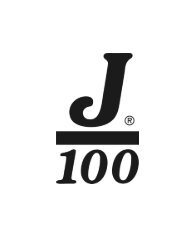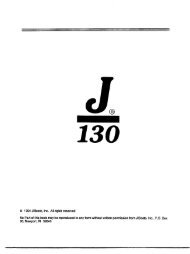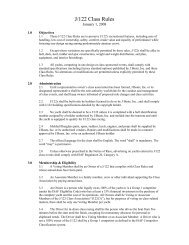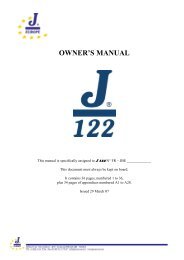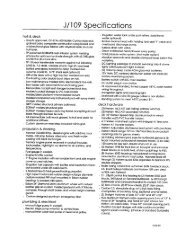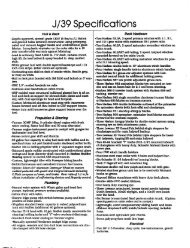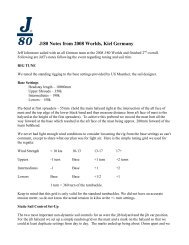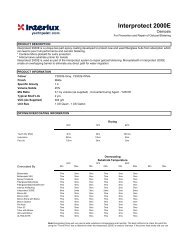J105 Owner Manual 2012.pdf - J/Owners
J105 Owner Manual 2012.pdf - J/Owners
J105 Owner Manual 2012.pdf - J/Owners
Create successful ePaper yourself
Turn your PDF publications into a flip-book with our unique Google optimized e-Paper software.
J/105 <strong>Owner</strong> Guide ...................................................................................................................................................................................................................................................... 41 <br />
Cabin Ports <br />
The ports are made of acrylic and are highly impact resistant. However, avoid highly abrasive <br />
cleansers which can scratch them. Instead, use mild soap and water to clean ports. Avoid <br />
chemical solvents, notably acetone, which can "melt" the ports...i.e. smear its smooth finish. <br />
DO NOT PERMIT ACETONE OR TEAK CLEANER TO GET ON PORTS OR HATCHES AS THEY WILL <br />
DISINTEGRATE AND “BLUR.” <br />
Stainless/Chrome <br />
Salt is an extremely corrosive element and whenever possible owners should spray all stainless <br />
and chrome deck hardware with a healthy amount of fresh water after sailing each day. <br />
Hardware like the pedestal guard, stanchions, handrails, bow/stern pulpits, and winches can be <br />
treated with Never-‐dull® or other light cleansers. After applying cleanser, polish to a gleam with <br />
a clean cotton rag. For more aggressive cleaning a product called Wichinox (made by French <br />
company Wichard) has been highly recommended for cleaning and protecting SS. <br />
Optional Wheel Steering System <br />
Your steering system is the most important system on board your boat <br />
As with all mechanical systems used in the harsh marine environment, proper inspection and <br />
maintenance is required for long life and years of proper service. Systems that have not been <br />
maintained and lubricated properly may show signs of wear early and perform less than <br />
satisfactory. Therefore, it is important that all boats fitted with wheel steering systems get an <br />
annual inspection of the critical system parts and that routine maintenance guidelines are <br />
followed. <br />
Jefa Rudder Bearings & Gaiter <br />
Bottom Bearing -‐ The bottom bearing doesn't need any maintenance except for a good hose down <br />
when the boat is taken out of the water. The main reason for this hose down is to remove the salt <br />
water out of the bearing housing so it can't crystallize. If the shaft rotates irregularly, it could be <br />
that some rollers have developed a flat side. <br />
The exchange of the rollers is quite simple: Lower the rudder out of the boat. Remove the thin <br />
Delrin ring holding the roller track. Now the rollers and roller track will fall out. Mount the new <br />
rollers. To ease this job one can apply a film of detergent (soap) to the inside of the bearing <br />
housing, so the rollers will stick (NEVER use any grease). Mount the bottom roller track again <br />
and clip-‐in the newly supplied Delrin ring. <br />
Top Bearing -‐ The top bearing doesn't need any maintenance. Unless the bearing is exposed (no <br />
deck cover present) one should yearly hose it down to wash away any sand and dust between the <br />
rollers and the housing. <br />
Gaiter -‐ Gaiters should be inspected yearly for mechanical damage. Carefully inspect the complete <br />
gaiter surface if any cracks are present, especially around the clamps. If you don't trust the <br />
sealing capabilities of the gaiter any more, replace it with a new one. Gaiters can be supplied in <br />
unglued state, so the rudder shaft doesn't have to be dropped. Bend the new gaiter around the



